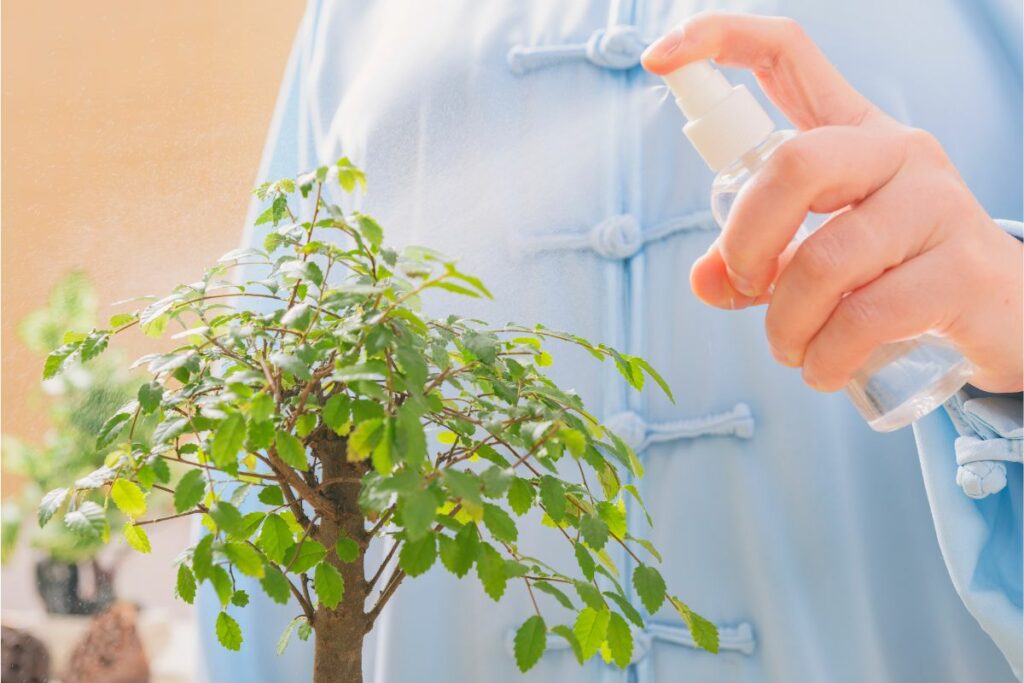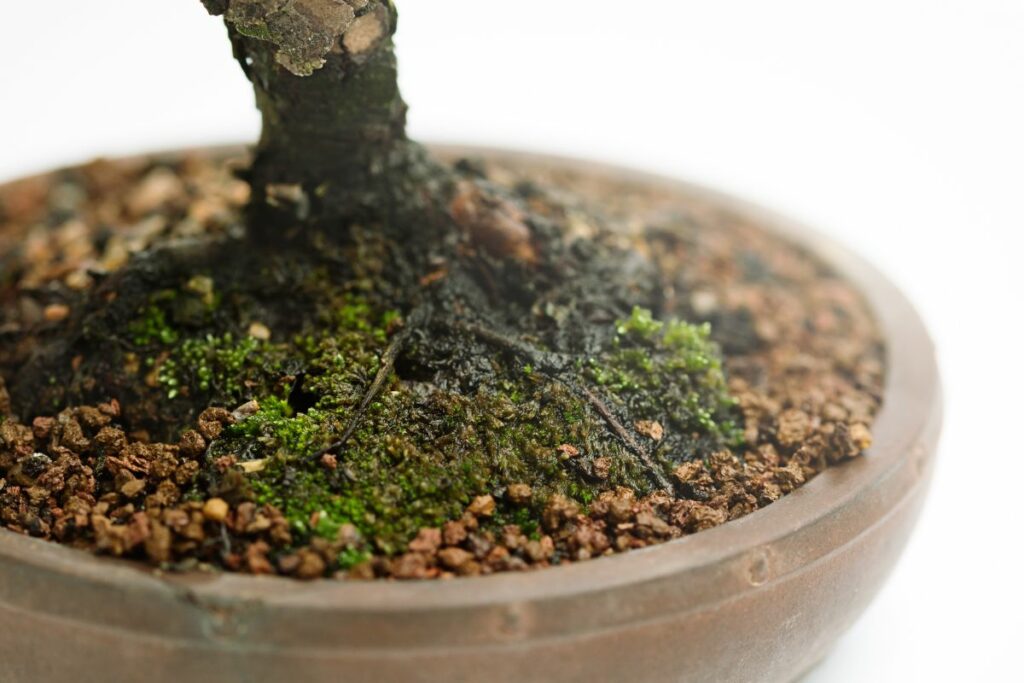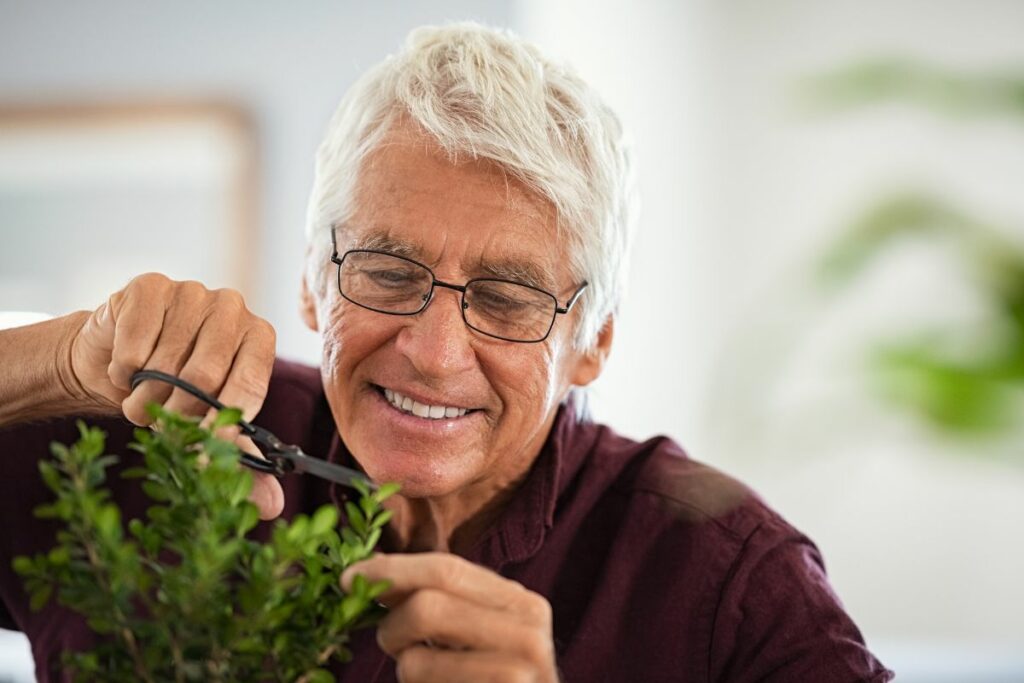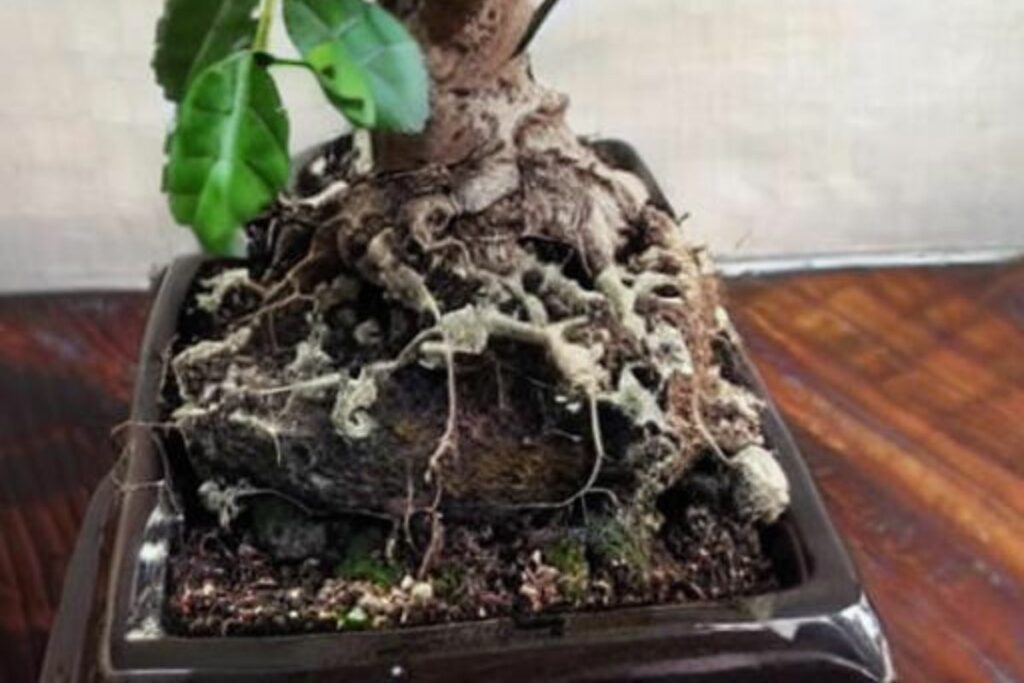Mold growth on bonsai trees can be a serious problem for home gardeners, but it doesn’t have to be. With the right knowledge and preventative measures, you can keep your bonsai healthy and thriving. In this article, we’ll discuss some of the common causes of mold growth on bonsai trees, as well as how to get rid of it if it does occur.
The first step in preventing mold growth is understanding why it occurs in the first place. Mold is caused by moisture buildup around the roots or trunk of a bonsai tree, usually from over-watering or poor drainage. If water doesn’t evaporate quickly enough from the soil surface, then mold will start to form and spread. Other factors that can contribute to mold growth are too much humidity or not enough sunlight.
Finally, once you’ve identified the cause of mold growth on your bonsai tree, you need to know how to get rid of it. This can involve changing your watering habits and improving drainage around the roots of your tree. You may also need to make adjustments to your environment such as reducing humidity levels or increasing sunlight exposure. Doing so will help reduce the chances of future mold growth and help keep your bonsai tree healthy and vibrant!
1. What Is Mold Growth?
Mold growth is a common problem for bonsai tree owners. It appears as fuzzy, gray or white spots or patches on the leaves and branches of the tree, which can be both unsightly and detrimental to the health of the plant. Mold growth is caused by several different factors, such as poor air circulation, too much humidity in the environment, and overwatering. All of these issues can lead to an increased amount of moisture around the bonsai tree and create a perfect environment for mold spores to grow.
When dealing with mold growth on a bonsai tree, it’s important to take immediate steps to address the issue. The first step is to reduce the amount of moisture present by increasing air circulation in the room where the tree resides. This can be done through opening windows or using fans. Additionally, reduce watering sessions so that only enough water is used to keep soil moist but not soggy. Lastly, consider investing in a dehumidifier if there’s too much humidity in your home environment.
To get rid of existing mold growth on your bonsai tree, you should use a fungicide spray specifically designed for plants that are safe for use on bonsai trees. Follow manufacturer instructions carefully when applying fungicides and ensure that all surfaces are thoroughly covered with product. After application, monitor your tree closely and reapply fungicide if necessary until all signs of mold have gone away completely.
2. What Causes Mold Growth On Bonsai Trees?
Mold growth is a common problem when it comes to bonsai trees, and understanding the causes is fundamental to preventing it. There are several factors that can lead to mold growth on bonsai trees, and they should be taken into consideration when maintaining your tree. In this article, we’ll discuss what causes mold growth on bonsai trees and how to get rid of it.
One of the main causes of mold growth on bonsai trees is high humidity levels. If the environment around your tree is damp or humid, then it’s more likely that mold will grow. Such humid conditions can be caused by poor air circulation, overwatering, or even just the natural environment of your home.
Another cause of mold growth on bonsai trees is inadequate drainage. If the soil around your tree is too wet or soggy, then it can create an ideal environment for mold to grow. To prevent this from happening, make sure that you are not overwatering and that
Additionally, improper watering can also cause mold growth as too much water can make the soil stay wet for long periods of time.
Another major cause of mold growth on bonsai trees is poor air circulation. If there’s not enough airflow in the environment your tree is in, then moisture will linger in the air and settle onto its leaves and branches, leading to mold formation. Furthermore, if you’re keeping your tree indoors, make sure you keep windows open during hot or humid days to allow fresh air circulation.
It’s important to take steps to prevent mold from growing on your bonsai tree by controlling humidity levels and ensuring proper watering techniques as well as good airflow around the plant. If you already have a problem with mold growth on your tree, then there are some methods which you can use to get rid of it such as using fungicides or pruning away affected areas.
3. Identifying Mold Growth On Bonsai Trees
Mold growth on bonsai trees can be identified through some common visual cues. The first indicator is the presence of white, gray or black circles on the surface of the leaves. At times, this discoloration may appear scaly and powdery. Mold growth on bonsai trees can also manifest itself in fuzzy patches or webs on the leaves and branches. If these signs are present, it’s important to take action quickly to prevent further damage to your tree.
Another sign of mold growth is microscopic spores that may be visible under a microscope. These spores are usually light brown or yellow in color and are extremely small – about one-tenth of a millimeter in size! If you suspect your bonsai tree has mold growth, it’s important to inspect its soil as well. A dark-colored layer on top or around the roots could be an indication of mold growth in the soil.
It is also possible to get rid of mold growth by pruning affected branches and leaves, removing dead foliage from around the tree, improving air circulation around the bonsai tree, increasing sunlight exposure and applying a fungicidal spray to combat any remaining fungus. Taking preventive measures such as avoiding over-watering and ensuring that drainage is good should also help prevent future outbreaks of mold growth on your bonsai tree.
Taking these steps can help ensure that your bonsai tree remains healthy for years to come! With proper care and maintenance, you can enjoy beautiful specimens for generations to come.
4. How To Prevent Mold Growth
Mold growth is a common problem for bonsai trees, and it’s important to know how to prevent it so that you know what to do in the event of the next fungal infection. Fortunately, there are several steps we can take to reduce the risk of mold growth in our trees. In this article, we’ll explore four key strategies for preventing mold growth on bonsai trees.
First, it’s important to keep the soil of your bonsai tree moist, but not overly wet. Too much moisture can create an ideal environment for mold to grow. You’ll want to check the soil regularly and water as needed. It’s also a good idea to let the soil dry out slightly between waterings so that it doesn’t become too damp.
Second, proper pruning and fertilizing can help reduce the risk of mold growth. Pruning away dead or diseased branches can help reduce the amount of moisture in the air around your tree and make it less hospitable for mold spores. Fertilizing with a balanced fertilizer can provide additional nutrients that will help keep your tree healthy and better able to resist mold growth.
Finally, it’s important to pay attention to environmental factors such as temperature and humidity levels as these play a role in determining if your tree is more likely or less likely to experience mold growth. Keep an eye on local weather conditions and adjust your watering schedule accordingly if necessary – for example if temperatures are particularly high or low you may need to increase or decrease watering frequency respectively. Paying attention to environmental factors can go a long way towards helping keep your bonsai tree free from mold!
5. Adequate Watering & Drainage

Firstly, proper watering is essential for preventing mold growth on a healthy bonsai plant. If the soil remains too wet or moist, it can cause mold to form. It’s important to only water when the soil feels dry, and not water until the soil is completely dry. This will help ensure that the roots are getting enough water while preventing mold from forming.
Secondly, adequate drainage is also crucial in preventing mold growth on bonsai trees. The root system needs to be able to take up moisture and oxygen properly. If the soil does not drain well, it can lead to standing water, which can cause root rot and attract mold spores. To ensure good drainage, use a mix of 50 percent loam and 50 percent sharp sand or grit for your bonsai tree’s potting mix.
Finally, it’s important to use a well-draining pot with plenty of holes in the bottom for excess water to escape from. This will help prevent any water from pooling at the bottom of the pot and leading to potential root rot or other issues that can attract and allow for mold growth. Additionally, make sure you’re using high quality pots that don’t absorb too much moisture and are easy to clean so you can prevent any buildup of debris where mold could potentially grow.
6. Proper Air Circulation

Proper air circulation is an essential factor in preventing mold growth on bonsai trees. Without proper air circulation, the tree’s environment can become stagnant, trapping moisture and providing a breeding ground for mold. To ensure adequate airflow around your bonsai tree, you should keep its pot in an open area where it is not blocked by furniture or other obstacles. Additionally, you should occasionally move your bonsai tree to a different location so that it gets a fresh supply of air from all directions, and never have lack of oxygen.
When repotting your bonsai tree, be sure to use well-draining soil and provide plenty of drainage holes in the bottom of the pot. This will help keep excess water from collecting around the roots, which can cause them to rot and attract mold. Additionally, if you are using a shallow pot for your bonsai tree, make sure to put some stones or gravel at the bottom of it before adding soil; this will help promote better air circulation throughout the pot.
Finally, it’s also important to regularly clean away any dead leaves or debris from around your bonsai tree as these can easily become breeding grounds for mold spores. If you spot any signs of mold on your bonsai tree’s leaves or branches, spray them with an antifungal solution immediately and then increase the amount of air circulation around it. Taking these steps will help ensure that your bonsai tree stays healthy and free from unwanted pests like mold.
7. Correct Potting Mix

One of the most important factors in preventing mold growth on bonsai trees is to use the correct potting mix. This is because soil that won’t hold too much water, but also has enough nutrients, helps keep moisture levels balanced. As a result, you can avoid problems with excessive wetness and humidity, which are ideal conditions for mold growth.
When choosing a potting mix, look for one that is light and airy with good drainage capabilities. Avoid any mixes that contain peat moss or other components that retain more moisture than necessary. If you’re not sure what type of soil to use, it’s best to consult an expert who specializes in bonsai trees, as they will be able to give you advice on the best options available.
Another important aspect of avoiding mold on your bonsai tree is to make sure that there is adequate air circulation around the plant. This means keeping the tree away from walls and other obstructions so air can move freely around it. Additionally, try to avoid overcrowding your plants or placing them close together since this can inhibit airflow between them and create an environment where mold is more likely to occur.
8. Avoid Wetting The Leaves
When it comes to preventing mold growth on bonsai trees, one important factor is avoiding wetting the leaves. This is especially true when you’re using a spray bottle or hose to water your tree. The moisture that gathers on the leaves can create an ideal environment for mold and mildew growth. The best way to avoid this is by watering sparingly at the root of the tree and not directly onto the foliage. If you must use a spray bottle, be sure to keep it at a distance from the leaves.
Avoiding wetting the leaves is also important during cold weather months when temperatures drop below freezing. If you water your bonsai tree and then temperatures fall, any moisture that’s present on the leaves can freeze and cause damage to them. It’s best to wait until temperatures rise before attempting to water again. Additionally, if there are any signs of frost or snow on your bonsai tree, do not attempt to melt them with water as this can also harm your tree.
In order to keep mold and mildew away from your bonsai tree, take care not to water its leaves directly and in cold weather, wait until temperatures rise before attempting again. Keeping these two tips in mind will help you maintain a healthy bonsai tree and prevent any health-related issues due to mold growth.
9. Pruning The Leaves To Remove Mold

Pruning the leaves of a bonsai tree can help to remove mold. This is an important step in preventing and treating mold growth. Pruning the leaves removes the infected areas, which helps to stop the spread of the mold. It also allows for increased airflow around the tree, which inhibits future mold growth.
When pruning, it’s important to use shears or scissors that have been disinfected with alcohol or bleach. Doing so helps to reduce the risk of spreading the mold further. It’s also important to note that pruning only removes existing growths; it won’t prevent future ones from occurring. Furthermore, any dead wood should be removed as well as any parts of branches that are affected by mold.
In addition to pruning, other measures can be taken to prevent and treat mold on bonsai trees. Keeping humidity levels low is important, as is avoiding wetting the leaves and ensuring adequate drainage at all times. Additionally, applying fungicides periodically may help to keep further outbreaks from occurring. Taking these steps will ensure that your bonsai tree stays healthy and free from harm caused by mold growth.
10. Treating The Tree With An Antifungal Product
Mold growth on bonsai trees can be caused by a variety of environmental factors, such as high humidity and poor air circulation. Fortunately, there are ways to treat the mold in order to restore the health of the tree. One method is treating the tree with an antifungal product.
Using an antifungal product is one of the most effective ways to get rid of mold on a bonsai tree. The product should be applied directly to any affected areas on the tree, such as leaves or branches. To ensure that all parts of the tree are thoroughly treated, it’s important to also spray some of the product onto surrounding surfaces and soil. Additionally, it’s helpful to use a fungicide that contains both curative and preventative properties so that any future outbreaks can be avoided.
Once you’ve treated your bonsai tree with an antifungal product, it’s important to monitor its condition and make sure that no new mold growth appears. If you find any signs of further infestation, then you may need to reapply the antifungal product in order to stop it from spreading further. Regular pruning and adequate ventilation can also help prevent future mold problems and keep your bonsai healthy for many years to come.
Keeping your bonsai clean by wiping down its leaves regularly is another essential step in keeping it safe from mold growth. Wiping down leaves will not only remove dirt and debris but also discourage fungi spores from forming on them. Furthermore, making sure that your bonsai has plenty of access to fresh air can also help reduce humidity levels around it and decrease chances for mold growth.
Frequently Asked Questions
How Often Should I Check For Mold Growth On My Bonsai Tree?
It is important to regularly check for mold growth on your bonsai tree, as it can be a sign of poor plant health. Mold growth can occur for a variety of reasons, such as overwatering, poor air circulation, or high humidity levels. By monitoring your bonsai tree’s environment and taking the necessary steps to prevent mold growth, you can ensure that your tree stays healthy.
When checking for mold growth, start by examining the trunk and branches of the tree. Look closely at any areas that are damp or have been recently exposed to water. Additionally, inspect any soil around the base of the tree for signs of discoloration or fungal growth. If you notice any signs of mold growth on your bonsai tree, take immediate action to remove it.
Mold removal should involve cleaning off any visible fungal growth with a damp cloth or brush. You should also reduce moisture levels in the air by opening windows or running fans if possible. If there is still evidence of mold after these measures have been taken, consider repotting your bonsai tree in fresh soil and pruning away affected branches. With regular maintenance and attention to detail, you can keep your bonsai tree free from mold growth and maintain its health over time.
Is Mold Growth Harmful To The Tree?
Mold growth can be concerning for bonsai tree owners, so it is important to understand whether or not it is harmful. To learn more about mold growth on bonsai trees and the potential risks, let’s explore the topic further.
The presence of mold on a bonsai tree can be caused by several factors, including high humidity and poor air circulation. This can cause mold spores to become airborne and land on the tree’s leaves or branches, leading to mold growth.
When left untreated, this type of mold can cause damage to the tree’s foliage and stunt its growth. In addition, it can create an environment that encourages other pests or diseases to develop, further compromising the tree’s health. Therefore, if you notice any signs of mold on your bonsai tree, it is important to take action quickly in order to protect your plant from further harm.
To reduce the risk of mold growth on your bonsai tree, it is important to maintain a balanced humidity level in your home and provide adequate air circulation around the plant. Additionally, make sure you inspect your bonsai regularly for any signs of mold so that you can take swift action if necessary. Taking these steps will help ensure that your beloved bonsai stays healthy and vibrant for years to come!
Are There Any Natural Remedies To Prevent Mold Growth?
Mold growth on a bonsai tree can be detrimental to its health and longevity. While it is difficult to completely prevent the growth of mold, there are some natural remedies that can help. In this article, we’ll discuss what causes mold growth on bonsai trees, as well as how to naturally prevent and get rid of it.
One of the most common causes of mold is from excessive moisture or humidity. When the soil around a bonsai tree has too much water in it, it can create an environment where mold begins to grow. Another cause of mold growth could be due to poor air circulation around the tree; if there isn’t enough air flow, then it’s more likely for moisture and humidity to build up and lead to mold.
Thankfully, there are some natural methods for preventing and getting rid of mold on bonsai trees. One way is by keeping the soil dry – water thoroughly when needed but don’t overdo it! Additionally, trimming the leaves may help with air circulation and reduce any moisture that accumulates around them. Finally, adding fungicides such as neem oil or baking soda mixed with water can be sprayed onto the surface of the plant in order to further protect against any fungal diseases or molds that might develop over time.
It’s important to remember that prevention is key when it comes to dealing with mold on bonsai trees. Taking steps such as watering correctly, pruning regularly and using natural fungicides will go a long way in ensuring that your bonsai tree stays healthy and free from any unwanted fungi or molds. With a bit of care and attention, you should have no problem keeping your bonsai tree safe from potential harm caused by excessive moisture or humidity buildup!
Is There A Way To Test The Soil To Determine If It Is Suitable For Bonsai Tree Growth?
Soil is a key factor in bonsai tree growth and can be the cause of mold growth if it’s unsuitable. Testing your soil can give you an idea of what nutrients are lacking or what needs to be added, as well as whether the soil is conducive to bonsai tree growth. This can help you prevent mold from occurring in the first place.
Testing your soil doesn’t have to be complicated. You can take a sample of the soil and bring it to a lab for testing, or you can purchase a DIY kit that tests the pH levels of the soil and checks for other elements like nitrogen and phosphorus. Both options will provide information on what adjustments need to be made in order to make your soil suitable for bonsai trees.
If you’re ever unsure about your soil conditions, it’s important to get it tested and make any necessary adjustments before planting your bonsai tree. Not only will this ensure that your tree has optimal growing conditions, but it’ll also help minimize the chances of mold growth due to unsuitable conditions. Taking these extra steps now could save you time and money down the line!
What Is The Best Way To Water A Bonsai Tree To Prevent Mold Growth?
Watering a bonsai tree correctly is essential to preventing mold growth. The key is to water the tree consistently and only when it’s necessary. Too much water can lead to problems like root rot, while too little water can cause the bonsai’s soil to become dry and brittle.
It’s important to check the soil regularly to see if it needs more moisture or not. If you’re unsure, use your finger or a wooden skewer to test the soil’s moisture level. If it feels dry more than two inches down, then it’s time for watering. Using a watering can with a nozzle that has small holes also helps ensure that you don’t over-water your bonsai tree. When watering, make sure you apply enough pressure so that the water penetrates into the soil but not enough to wash away any loose particles or debris.
Maintaining proper humidity levels also helps reduce mold growth on bonsai trees. If possible, keep your bonsai indoors in an area that has good air circulation, such as near an open window or door. You can also mist the plant with a spray bottle filled with lukewarm water once a day or every other day depending on how humid the environment is. Finally, try placing pebbles around your bonsai pot and adding some distilled water on top of them – this will help create a humid microclimate around your tree which should help prevent mold from growing.
By following these steps, you should be able to maintain a healthy and mold-free bonsai tree!
Final Words
Certain mold growth on bonsai trees can be a serious issue. It’s important to check for signs of mold growth on your tree often, and take steps to prevent it if necessary. If you’re not sure what kind of soil is best for your tree, testing the soil beforehand is highly recommended. And when watering your bonsai tree, it’s essential to make sure the soil doesn’t become overly saturated as this can lead to an increase in mold growth. With proper care and maintenance, you can ensure that your bonsai tree remains healthy and free from any unwanted mold growth.
I hope this article has been helpful in providing information about causes of mold growth on bonsai trees and how to get rid of them if they appear. Remember that regular monitoring is the key to preventing mold growth and keeping your bonsai healthy. If you follow these tips, you’ll be able to enjoy your beautiful bonsai tree for many years to come!
Thanks for reading and good luck with taking care of your bonsai tree!

